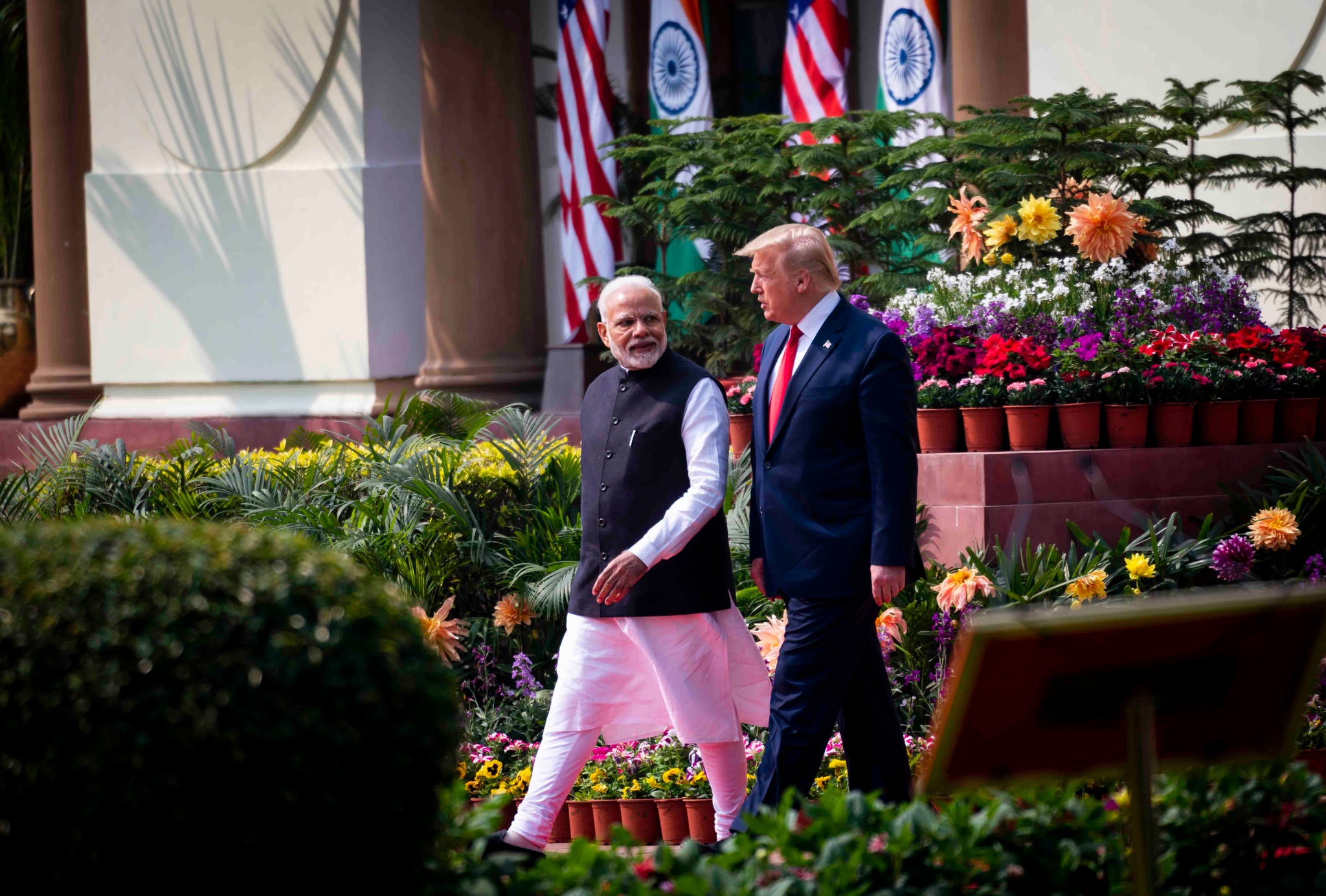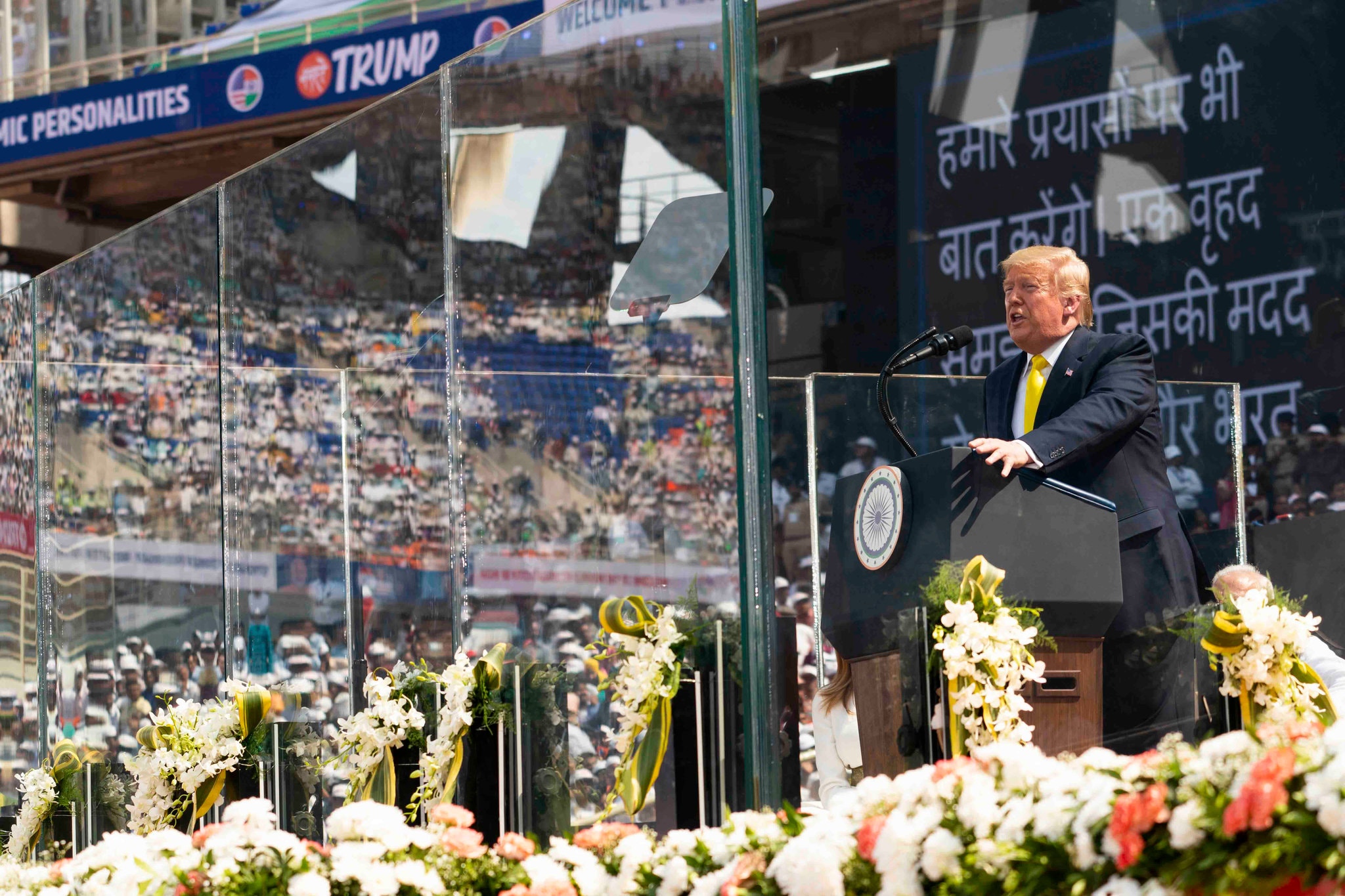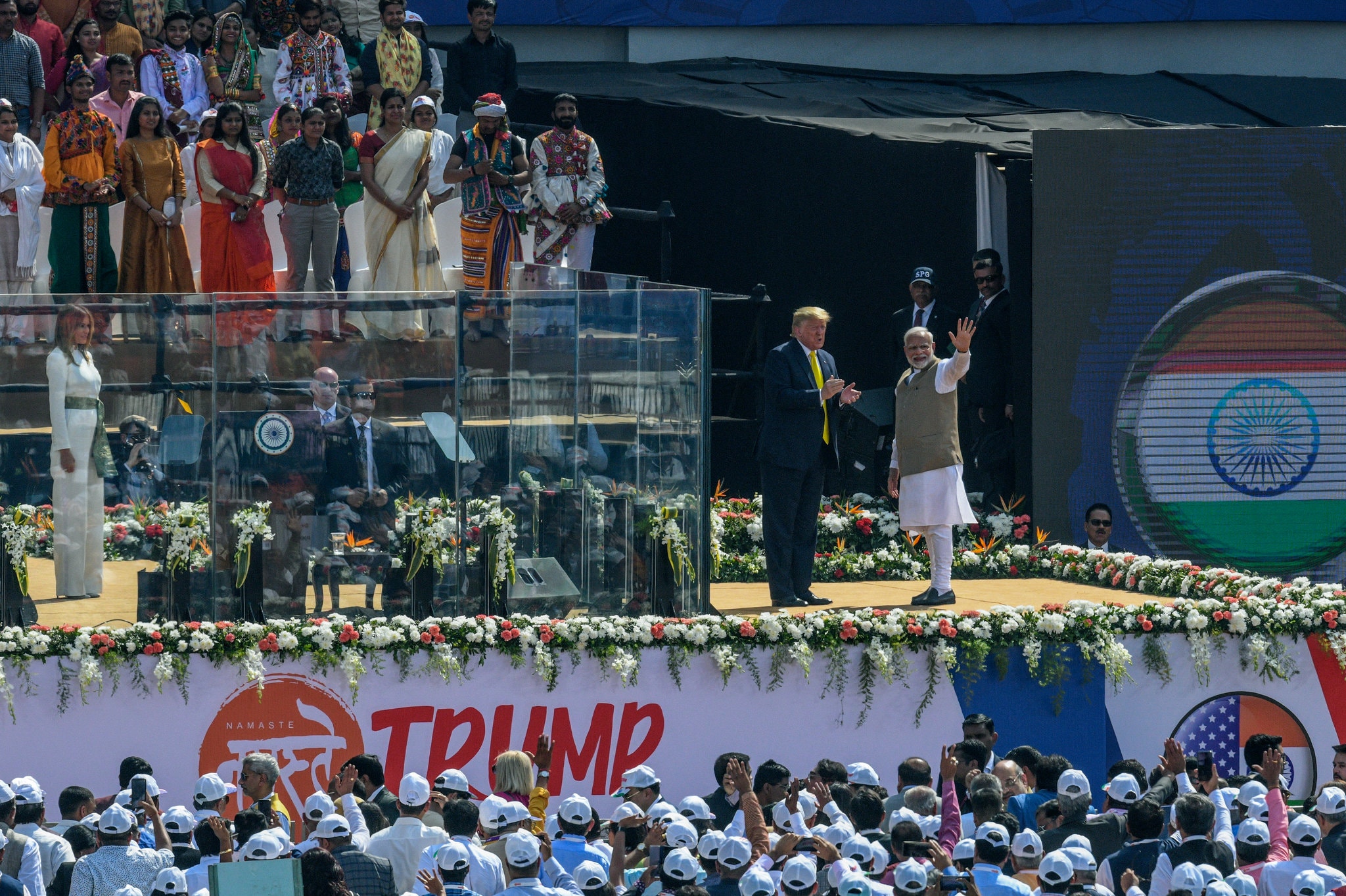Introduction: the author of this article is Mr. Pravin Sawhney, editor of the FORCE news magazine, India.
(Credit: The New York Times)
After the recent two-day jamboree (February 24 and 25) of President Donald Trump to India, relations between India and the United States have been elevated to Comprehensive Global Strategic Partnership (CGSP). This is significant. How much the CGSP delivers would depend on two factors.
One, India’s acceptance of U.S.’ Blue Dot Network proposal discussed during the Trump visit as a purported answer to China’s Belt and Road Initiative (BRI). Accepting it could result in India taking a hardened position on possibility of cooperation with China’s BRI through the Wuhan understanding of India-China-Plus mechanism.
Two, strategic trust, which remains wobbly.
What is equally important from CGSP’s perspective is the distance the two sides have traversed since 1991 when the U.S. Lt Gen. Claude M. Kicklighter visited India to explore military cooperation. The outcome of 29 years of bilateral relationship, with its ups and downs, is expected to give political, security, defence and military fillip to the elevated partnership.
Traditional wisdom informs that India, under Prime Minister Narendra Modi would likely invest wholeheartedly in the CGSP since the strategic fraternity believes that closeness with Washington deters China. There has been little basis to support this thesis especially after the coming of the fifth-generation leadership under general secretary Xi Jinping in China in November 2012. Another reason for comfort with the U.S. has been the absence of the Soviet Union. Despite chanting the mantra of strategic autonomy, India has, since Independence, always carved a regional role for itself under the benediction of a global power. In the present century, the U.S. has replaced the Soviet Union.
The bilateral cooperation, however, would have remained an unconsummated marriage, had the U.S. not taken the lead by inserting substance into the CGSP which addresses the regional Free and Open Indo Pacific strategy. The reason for this half-hearted outreach has been India’s unwillingness to publicly identify China as the source of its strategic and military quandary. Consequently, India’s strategic dilemma, overtime, would have increased not diminished as BRI would have crept closer home into South Asia.
(Credit: The New York Times)
To place the CGSP into perspective, there is a need to step back. On May 30 2018, the Trump administration renamed its Pacific Command as the Indo-Pacific Command to signal the centrality of India. This was a quantum jump from the U.S. Bush administration’s reference to India in March 2005 as the net security provider in the Indian Ocean Region (IOR) — a phrase that Indian admirals have been unable to understand in quantifiable military terms. The region spanning the two oceans — Western Pacific and Indian — which is the responsibility of the Indo Pacific Command, has got a new name as well: Indo Pacific region.
The stage was set for the geostrategic clash of the century between the US-led Indo-Pacific strategy and the China- (and Russia) supported Asia Pacific strategy. The Modi government’s acceptance of the CGSP would suggest bolder Indian participation in the Indo-Pacific strategy. This is a big deal since the U.S. appears to have got India onboard its strategy without naming China — the target of its strategy.
According to the joint statement issued after the Trump visit: Prime Minister Modi and President Trump decided to strengthen consultation through the India-US-Japan trilateral summits; the 2+2 Ministerial meeting mechanism of the Foreign and Defence Ministers of India and the United States; and the India-US-Australia-Japan Quadrilateral consultations, among others. Prime Minister Modi and President Trump looked forward to enhanced maritime domain awareness sharing among the United States, India, and other partners.
While India’s acceptance of the Indo-Pacific strategy has never been so clear, the emphasis on the joint statement suggests highest level of political deliberations; not on the military aspects though which have (deliberately) been kept limited to information sharing between India and the U.S. and other major democracies apprehensive about China’s rise. The reason for this is that, unlike the Asia-Pacific strategy, the Indo-Pacific strategy is still a concept without key ingredients: clearly defined adversary, roadmap and mechanism to manage the adversary. This is what political confabulations are expected to deliver, if at all.
The BRI as a well-rounded strategy has four constituents intertwined in one whole. These comprise infrastructure building to facilitate commerce and trade; digital globalisation by the Digital Silk Road incorporated in BRI in 2015; the People’s Liberation Army’s involvement in order to protect Chinese assets in BRI nations; and above all, a grand strategy called China Dream. The BRI promises prosperity and cooperative security to all nations on its bandwagon through its clarion call — Asia for Asians. The underplayed story here is that since the two security architectures cannot coexist, the BRI, unveiled to the world in 2013, has stolen a lead over the 2018 Indo-Pacific strategy.
Moreover, the Indo-Pacific strategy has two major challenges. The first is the lack of economic component to support the military rebalance to Asia. After the Trump administration withdrew from the Tran-Pacific Partnership, it has been floundering for an economic constituent to support its strategy. Some progress hopefully can be made during the recent Trump visit. As suggested in the joint statement, Prime Minister Modi and President Trump expressed interest in the concept of the Blue Dot Network, a multi-stakeholder initiative that will bring governments, the private sector, and civil society together to promote high-quality trusted standards for global infrastructure development.
There is, however, little clarity on Blue Dot Network except that it would be a transparent and inclusive connectivity infrastructure building that avoids sovereign debt in low income nations — reference to the BRI. Officials said that Japan, Australia and South Korea were onboard Blue Dot before this was proposed to India by the visiting Trump team. However, dampening the enthusiasm was a report published on January 28 by the Washington-based Centre for New American Security who said the U.S.’ efforts in the Indo-Pacific region remained ‘inconsistent, uncoordinated and under-resourced.’
The problem is compounded by the transactional and nationalistic (as opposed to globalist) disposition of the Trump administration. This does not inspire confidence in the Indo-Pacific strategy. For example, during the Trump visit, defence deal for U.S. helicopters worth over USD 3 billion was signed with the promise of many more deals under active consideration by India. Estimates put defence trade of USD 18 billion in a decade. This is not all. India has promised purchase of U.S. gas and oil with likely purchase of six U.S. nuclear reactors under the 2008 civil nuclear deal. Yet, an unhappy President Trump said that he hoped for a bigger trade deal with India. On return to the U.S., all that Trump said was that billions and billions of dollars would come from India.
The second challenge for India is strategic trust deficit, made critical by the in-the-face emphasis on the defence and military component of the Indo-Pacific strategy. Since this issue is bipartisan and fundamental to bilateral relations, it needs an elaboration.
The single important reason for trust shortfall is the long-held promise by the U.S. to give high and dual-use technology to India. India first signed a Memorandum of Understanding (MOU) on technology with the U.S. in 1984. Under the MOU, when India asked for U.S.’ Cray-XMP-24 supercomputer, the U.S. denied since the supercomputer could assist in nuclear and ballistic missiles. The U.S., instead, gave a watered-down supercomputer — Cray-XMP-14 — to India.
After India’s 1998 nuclear tests, even when relations between India and the U.S. improved, Washington ruled out defence sales. Speaking with FORCE in August 2004, U.S. ambassador in India, David Mulford gave several reasons for doing so:
“First of all, the Indians have a history of acquiring arms from other sources. Second, India is sensitive about sanctions, even when they know that in the U.S., the Congress takes independent decisions on these issues. Third, the disruptions in the past have discouraged the U.S. defence companies from putting time and energy here. Not because of export licences, but because the atmosphere has not been very friendly. Now change always takes a while. India also has to be more trusting of the U.S. as a supplier and recognise that if you become a dependable buyer and create a relationship then both sides benefit from it”.
(Credit: The New York Times)
Then, the U.S. wanted to build trust with India by promising what India needed most: Defence and dual use technology. This was done by Prime Minister A.B. Vajpayee and President George W. Bush in January 2004 through the Next Steps in Strategic Partnership (NSSP) initiative in three phases. Started in January 2004, it comprised civil nuclear activities, civil space programme and high technology trade, and dialogue on ballistic missile defence. Trade in defence hardware was deliberately not included in the NSSP because it was felt that trade in weapons platforms should follow trade in technology. This was meant to ensure that enough strategic trust was built before India purchased war-fighting platforms which would need an uninterrupted supply of spares.
Excruciatingly slow and spread over three phases, the NSSP was India’s best hope — till date — to get U.S. technology. However, the then National Security Advisor, Brajesh Mishra told FORCE after superannuation that getting technology was not easy since the two sides had different opinions on what each was looking at. At the end of NSSP, India was looking at lifting of all restrictions on India’s civilian nuclear and space programme. This is not what the U.S. had in mind. They were looking at end-use verification and fissile material; in short, non-proliferation.
In President Bush’s second term in office, secretary of state, Condoleezza Rice changed the bilateral narrative: She wanted a tighter geopolitical embrace of India with two objectives — non-proliferation and interoperability (ability to fight together for a common mission) between Indian and U.S. militaries in Asia-Pacific. This led to Rice’s public declaration in March 2005 on Indian soil that the U.S. would help India become a major power. The NSSP was ended abruptly and a stage was set for signing the joint statement on July 18 2005 — commonly referred to as the civil nuclear deal — between Prime Minister Manmohan Singh and President Bush.
From the U.S.’ perspective, the deal was primarily about non-proliferation (getting Indian reactors under safeguards). The other deliverables for the U.S. were defence and civil nuclear reactors trade and interoperability. Amongst other things, India was promised membership of the non-proliferation cartels, namely, the Nuclear Suppliers Group, Missile Technology Control Regime, Australia Group, and Wassenaar Arrangement to allow a waiver to India to buy nuclear reactors (which can technically be used both for civilian and military purposes) and reprocessing technologies despite India not having signed the NPT. However, given China’s stance — India could become NSG member after signing the NPT or both India and Pakistan could be considered for the exclusive club membership — NSG remained elusive.
Having got little except nuclear fuel from the civil nuclear deal and being placed under tighter IAEA control through additional protocol, a new issue came up — payback to the U.S. defence companies which had played a big role in the passage of the civil nuclear deal. Consequently, after 2008, defence trade assumed importance for the U.S. The hope of cutting-edge technology for India was, however, kept alive.
Fast backward to 2012. As in the past, the U.S. in June 2012 proposed the Defence Technology and Trade Initiative (DTTI) to assuage Indian concerns about not getting U.S.’ cutting edge technologies. The DTTI has three tasks: Closure on pending defence deals; collaboration in research and development; and co-production. Interestingly, Defence Research and Development Organisation (DRDO) did not want cooperation on R&D. It only wanted the U.S. to provide specific solutions to the problems its research efforts were coming across.
To demonstrate its sincerity, India was made U.S.’ Major Defence Partner in June 2016. In August 2018, India became the third nation in Asia, after Japan and South Korea, to be elevated to Strategic Trade Authorisation–1 status for sharing selected U.S. technologies. The harsh reality, however, was pointed out by the well-known American analyst, Ashley Tellis. According to him, because the United States is a hegemonic power in the international system, all significant military technology transfers are conditioned fundamentally by an assessment of their impact on Washington’s capacity to preserve its unique supremacy, their consequences for global or regional stability, and their benefits for strategic ties with the recipient.
With little happening in defence technology trade, and with defence trade blossoming, the bilateral relationship sought succour in military exercises, where the U.S. endgame is interoperability for joint combat patrols. Speaking with FORCE in 2005, commander, U.S. Pacific Command, Admiral Harry Harris said that the U.S. wanted India to become the pivot (military role) in the Indian Ocean Region. To accomplish this, the need was for interoperability to undertake joint combat patrols.
Interoperability has three stages: commonality of equipment, joint doctrinal planning and joint training. Since 1991, when naval cooperation began with the U.S.’ Kicklighter proposals, the two militaries still remain at the first stage of interoperability. This is when the Indian military has done maximum exercises with the U.S. military than any other friendly militaries.
There are two reasons why bilateral military exercises are stuck at stage one: “Enhanced domain awareness”. One, the U.S. wants India to sign its four foundation agreements before “commonality of equipment” could be exploited fully for optimal domain awareness and real time information sharing. This is routine stuff that the U.S. does with its allies. After long reviews and change of agreement’s names, India signed the General Security Of Military Information Agreement (GSOMIA) in 2002, the Logistics Exchange Memorandum Of Agreement (LEMOA) in 2016, and the Communications, Compatibility and Security Arrangement (COMCASA) in 2018. Interestingly, all three agreements were signed by India’s right-wing governments (Vajpayee and Modi) since they place emphasis on perception management — close ties with the most powerful nation supposedly adds to the image of a muscular India.
The last foundational agreement called Basic Exchange and Cooperation Agreement (BECA) for geo-spatial cooperation, long held up, is expected to be signed next year. India believes that signing BECA might compromise its indigenous Navigation with Indian Constellation (NavIC), also called Indian Regional Navigation Satellite System (IRNSS), which has eight satellites in total built by Indian Space and Research Organisation (ISRO), and there are four satellites in geostationary and geosynchronous orbits, respectively.
NavIC provides two types of services: standard positioning services for commercial use and encrypted restricted service for military use. This is done through the military communication satellites called GSAT series for the army, air force and navy. Covering extending region of up to 1,500km from Indian boundaries, NavIC is believed to score better that U.S.’ commercial GPS in terms of identification and accuracy. Since all satellites around the whole world, have their electromagnetic frequency band fixed which cannot be changed after launch, they remain highly vulnerable to cyber-attacks. By signing BECA, the U.S. might get access to IRNSS and the GSAT satellites, which assist guidance of Indian ballistic and cruise missiles. This could adversely affect them.
However, following the Trump visit, India may consider signing BECA. This confidence comes from the joint statement in which the two heads of government welcomed an endeavour by the Indian Space Research Organization (ISRO) and National Aeronautics and Space Administration (NASA) for development and launch in 2022 of a joint mission with the world’s first dual-frequency Synthetic Aperture Radar satellite, and applauded discussions that advance cooperation in Earth observation, Mars and planetary exploration, heliophysics, human spaceflight, and commercial space cooperation. Its successful conclusion might help building some strategic trust.
The other reason why bilateral exercises are unlikely to move towards interoperability is India’s concerns about vulnerability of its disputed land border with China. The difference between security and defence is understood by India. While teaming with the U.S. for combat patrols to guard the sea lanes of communications which could potentially be threatened by China, the bigger security matrix is still alarming. India’s immediate military apprehension is defence of its sovereignty and territorial integrity especially when post-Doklam, the Chinese threat on the Line of Actual Control has increased manifold: from that of excellent border management to forces-in-being. Thus, while bilateral or multilateral (with Quadrilateral member states) military exercises will be high profile, they would carry little substance. On numerous occasions, Indian navy chiefs have unequivocally said that they do not envisage military role with Quad member nations with which they train regularly.
Summing up, the Trump visit presents a mixed bag. While the Blue Dot Network holds hope, the joint dual frequency satellite holds promise for space cooperation which along with cyber has emerged as new war-fighting domains with disruptive technologies. Moreover, defence trade too is good for India. Even as cutting-edge technologies might not come, getting Indian public and private defence industries plugged into U.S. companies’ comprehensive and reliable global chains would produce enormous benefits.
The biggest unsaid issue in the bilateral relationship is that it is an unequal piece of music. India, as the weaker side would always end up doing more to keep the ball rolling. Successive Indian governments are not likely to mind this as good bilateral relationship is assessed as a stand-alone event which could propel it to the world stage. Given this, the Trump visit was a grand success.
(Credit: The New York Times)
(Please note: the above contents only represent the views of the author, and do not represent the views or positions of the Taihe Institute.)
—————————————————————
ON TIMES WE FOCUS.
Should you have any questions, please contact us at public@taiheglobal.org



